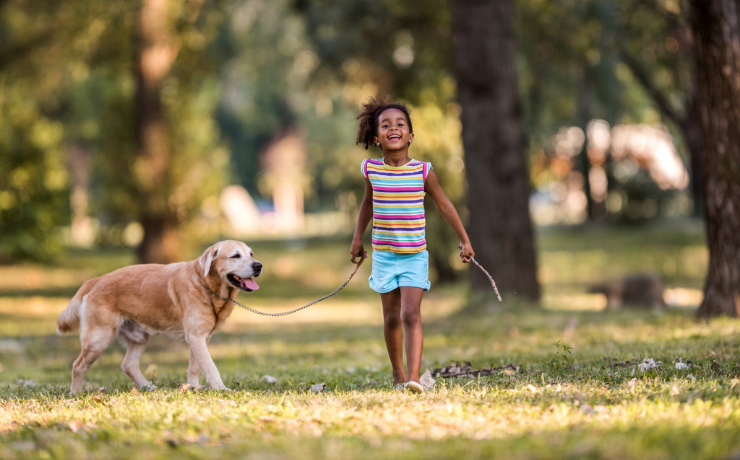We all know how much our four-legged companions love to walk. The mere mention of the word sends a pulse of excitement, as our dog’s tail begins to wag relentlessly, and they excitedly start pacing to and fro with the most adorable and innocent smiles on their faces. This excitement just makes the world seem beautiful, happier and brighter, doesn’t it?
But, did you know that dog walking has many fabulous benefits for pet parents as well? Many of us have discovered the inherent joys of dog walking but, there are still others who have not. If you’re one of these people, it’s time to educate, and inform you about these secret benefits of dog walking:
- Keeps You Both in Shape
Walking is a great form of exercise. Regular physical exercise will improve your and your beloved pet’s quality and duration of life. It is proven that walking has numerous health benefits and can help you avoid many physical ailments.
- Reduces Your Stress Levels
We live in a fast-paced world where we tend to face a lot of challenges in different aspects of our lives, which causes extreme stress in our lives. Walking with your dog can significantly lower these stress levels and act as a very good self-care activity. Scientifically, walking your dog can increase levels of the stress-reducing hormone, oxytocin, and reduce cortisol which is a stress-producing hormone in your body.
- An Easy Therapy Session
Dogs are proven to be excellent therapy animals for people with mental health conditions. Their friendly and affectionate nature creates a calming effect. They can make you feel loved and provide you with the confidence to banish your negative thoughts. So, a walk with them can easily be a way to connect with your dog when they are happy too.
- The Opportunity to Socialize
Humans are naturally social beings, when we go for a walk with our dogs it provides us with an opportunity to talk to new people or interact with our neighbours. Dogs also get a chance to socialize with other pets or street dogs which is good for their well-being. It can also be a social event which can lead to new friendships and a newfound sense of belonging with a community comprising other dog owners.
- Improve Your Dog’s Behaviour
A happy, fulfilled, and balanced dog will be a better-behaved dog. Dog walking provides you with the opportunity to help your dog burn off that excess energy that they have built up, but also allows you to seek teachable training moments for a better-behaved pet. It can alleviate hyperactivity and destructive behaviour in your dog.
- Strengthen Your Bond
Walking the dog is more than just ‘potty breaks,’ it is the time of the day when you and your dog spend time together for the sole purpose of enjoying each other’s company. This will make you both understand each other better.
Thus, a simple walk can solve a lot of your problems and without a lot of effort can provide you with great benefits. A 30-minute walk with your dog every day can help stimulate your dog’s mind enough to prevent behavioural problems like digging, barking, and other noisy habits that many dogs exhibit when they get bored or frustrated.
While going on these fun walks, a few things should be kept in mind. Here are a few tips and tricks from some dog owners to help make your next walk all the more special.
Arun Malik says, “Dogs have a spectrum of personalities like us humans, even within the same breed. If you feel like your dog is prone to aggression, it is wise to keep them on a leash in public places. And it’s better to opt for different routes because they provide different stimuli to the dog, which is especially important in puppyhood, as they need to get accustomed to various stimuli, some known, and some unknown, including but not limited to objects, people, and behaviour of people around them. This helps them develop a nature to deal with unknown circumstances and they grow to be confident adults. Confident and accustomed adult dogs are less likely to snap at people under stressed environments.”
Apoorva Jain advises other dog owners, “When you take your dog on a walk, it’s good to take a stick with you to protect your dog from other street dogs. You can also carry a water bottle with you in the summer, to quench your baby’s thirst during the walk. And make sure that you don’t let your dog pee or poop on pavements or the middle of the road, but only in mud-covered areas. It’s important to take the dog out for at least one run daily, especially the bigger dogs, to maintain their health.”
Devika Bahl also gives her insights that “Always carry a poop bag with you, to collect the poop once he/ she is done. We should always look out for cars and other vehicles on the road, because it may make the dog anxious or scared. Not every person in the park/ on the road is a dog lover, so limit dogs to people meeting on your walk and also don’t let them off the leash in public places. And lastly, don’t use a retractable leash because that makes it difficult for you to control your dog.”
Muskaan Ahluwalia strongly believes that “every pet-baby is different and it’s essential to understand that. My dog doesn’t adore very long walks. He likes to go out on trips and travel, but he doesn’t like walking for more than 30 minutes and we never push him too much. After all, your baby’s happiness and comfort should always matter more, right?”
Himanshu Pohani says, “We should take care of the dogs the same way they take care of our mental and physical health. Make sure you have them under control because the presence of your dog is not always as cute to other people as it is to you. Carry the poop scooper if possible, and make sure the harness is comfortable. Don’t let your puppy eat things from the road or unknown plants because you don’t know the risks.”
So, it’s time to get dressed, get your shoes on, grab a leash, prepare and take your fur baby out for a walk. After all, it’s going to be a beautiful experience for both you and them. Sounds like an amazing plan, doesn’t it?
































